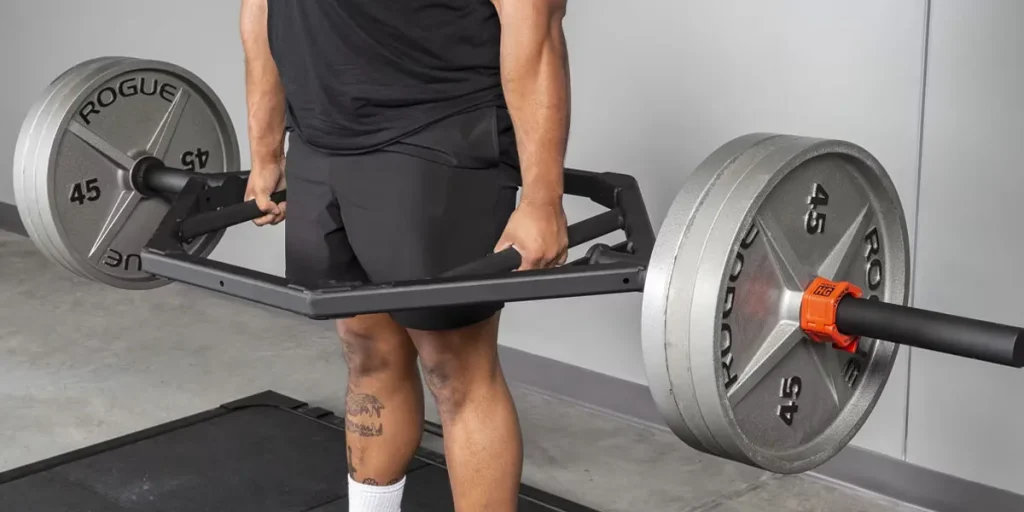A standard trap bar weighs about 45 pounds (20.4 kilograms). Different models may vary slightly in weight.
Exploring the intricacies of fitness equipment leads us to the trap bar, also known as a hex bar, which stands out for its hexagonal design.
This clever construction allows weightlifters to step inside the bar, offering a unique take on deadlifts and squats by aligning the weight with the user’s center of gravity.
Designed to reduce strain on the lumbar spine and improve lifting mechanics, the trap bar is a favorite among athletes and physical therapists.
With its weight comparable to that of a standard Olympic barbell, the trap bar is a versatile piece of equipment suitable for both home gyms and professional training facilities.
Its design and weight contribute to a safer and more effective lifting experience, catering to a wide range of fitness enthusiasts.

The Trap Bar: An Introduction
A trap bar, also known as a hex bar, is a piece of strength training equipment. It stands out in gyms due to its hexagonal shape.
This bar allows weightlifters to stand inside it to perform lifts. The trap bar is a versatile tool that targets a variety of muscle groups.
Origins Of The Trap Bar
The trap bar owes its birth to powerlifting circles. Introduced in the 1980s, it was designed to reduce the strain on the lumbar spine during deadlifts.
Its unique design has since gained popularity, becoming a staple in fitness regimes.
Design Elements That Affect Weight
The weight of a trap bar can vary. Several design elements dictate this:
- Material: Most trap bars are made from high-grade steel.
- Size: They can differ in size, influencing their weight significantly.
- Sleeve length: Longer sleeves allow for more weight plates.
Typically, a standard trap bar weighs around 45 pounds (20.4 kilograms). Heavier models can weigh upwards of 60 pounds (27.2 kilograms).
Standard Weights Across Different Models

Choosing the right trap bar means understanding the different weights available. Various models cater to different needs.
Let’s dive into the standard weights across commercial and specialty trap bars.
Commercial Gym Trap Bars
Commercial gym trap bars are a staple for weightlifters. They typically come in a standard range of weights. Here’s what you can expect:
- Average weight: 45 pounds (20.4 kilograms)
- Length: Varies between 4 to 6 feet (1.2 to 1.8 meters)
- Materials: Often steel for durability
Many commercial trap bars also feature dual or single handles, affecting the overall weight slightly.
Specialty And Custom Trap Bars
For unique needs, specialty and custom trap bars are perfect. Their weights vary based on design.
| Type | Weight Range |
|---|---|
| Lightweight | 25 to 35 pounds (11.3 to 15.9 kilograms) |
| Heavy-duty | 55 to 75 pounds (24.9 to 34 kilograms) |
| Custom Builds | Varies |
Custom trap bars can be tailored to any weight class depending on the user’s request and the manufacturer’s capabilities.
Each model is designed with different grip widths and distances to cater to the user’s build and lifting style.
Factors Contributing To Trap Bar Weight
Understanding the weight of a trap bar helps set the right expectations for your workout. Multiple factors can influence a trap bar’s weight. Let’s explore what those are.
Material Construction
A trap bar’s material greatly affects its overall weight. There are two common types:
- Standard Steel: Heavy and durable, ideal for rigorous training.
- Aluminum: Lighter, easier to handle, good for beginners.
Some trap bars feature additional coatings, such as chrome, enhancing durability and adding to the weight.
Dimensions And Sizing
The dimensions of a trap bar are key in determining its heft. Two main dimensions to consider:
- Bar Length: Longer bars equal more material and higher weight.
- Sleeve Length: Longer sleeves allow more weight plates, affecting the bar’s total potential weight.
| Dimension | Typical Measurement | Corresponding Weight |
|---|---|---|
| Bar Length | 4-6 feet | Varies |
| Sleeve Length | 10-16 inches | Increases with length |
Different brands may have slight variations in sizing, leading to differences in trap bar weight.
How To Determine Your Trap Bar’s Weight?

Understanding your trap bar’s weight is crucial in your strength training journey. It’s not just about the weight you load on each side; the bar itself contributes to the total weight you lift.
Discovering the exact weight of your trap bar can enhance your workout accuracy and progress tracking.
Methods For Accurate Measurement
Getting the true weight of your trap bar requires precision. Here are foolproof methods to ensure you hit the mark:
- Use a Scale: Place your bar on a reliable scale for a quick measurement.
- Check Manufacturer Specs: Look at your trap bar’s documentation for weight details.
- Calibrate Equipment: Verify your scale’s accuracy with calibrated weights before measurement.
Common Mistakes In Weight Assessment
Avoid these frequent errors to ensure an accurate trap bar weight assessment:
| Mistake | Impact |
|---|---|
| Ignoring Calibration: | Leads to incorrect scale readings. |
| Uneven Surface Placement: | Results in an unbalanced weight distribution. |
| Overlooking Bar Variations: | Not all trap bars weigh the same. |
Influence Of Trap Bar Weight On Strength Training
Choosing The Right Weight For Your Goals
Selecting the correct trap bar weight is crucial. It matches your fitness goals and ensures safety. A trap bar, also known as a hex bar, usually weighs between 45 to 75 pounds.
It’s perfect for deadlifts, shrugs, and squats. The right weight allows you to challenge your muscles without risking injury.
Matching Trap Bar Weight With Training Objectives
To achieve various fitness goals, you need different weights. Strength training requires heavier weights. They help build muscle power.
For endurance, use lighter weights and do more reps. Muscle toning needs moderate weights with higher reps.
- Strength Focus: Go for 70-85% of your one-rep max.
- Endurance Training: Stick to lighter weights at about 50-60% of your max.
- Toning Muscles: Choose a moderate weight for sets of 12-20 reps.
Adjusting Lifts For Optimal Performance And Safety
Proper weight choice prevents injuries. It ensures optimal performance during workouts.
Start with a lower weight to master form. Gradually increase the weight as you become stronger.
| Experience Level | Starting Weight % of Max | Increment Increase |
|---|---|---|
| Beginner | 40-50% | 5-10 pounds |
| Intermediate | 50-60% | 10-15 pounds |
| Advanced | 60-70% | 15-20 pounds |
Use rest days to let your muscles recover. Increase the weight only if you can do two reps more than your set target. Listen to your body. Pushing too hard leads to setbacks.
FAQs About the Weight of a Trap Bar
What Is The Average Weight Of A Trap Bar?
Trap bars typically weigh around 45 to 60 pounds (20 to 27 kilograms). This weight can vary depending on the brand and specific model of the trap bar.
Can Trap Bar Weights Vary By Type?
Yes, trap bar weights can vary. Standard trap bars weigh about 45 pounds, while heavier-duty models might weigh up to 75 pounds. There are also lighter versions for beginners.
How Does A Trap Bar’s Weight Affect Lifting?
The weight of a trap bar can affect lifting by changing the total load lifted. A heavier bar means more weight is lifted, which can influence the difficulty level and the potential for muscle gain.
Why Choose A Trap Bar Over A Traditional Barbell?
A trap bar offers a neutral grip and a central load distribution, potentially reducing strain on the lower back. This makes it a preferred choice for those with back concerns or looking to target specific muscles differently.
Conclusion
Wrapping up, the trap bar’s weight is crucial for lifting mechanics and overall training success. Standard bars typically hover around 45-55 pounds.
Yet, those used for specialized training may vary. Remember to factor in the bar’s mass when calculating total load for an accurate strength regimen.
Keep lifting smart!
Resources:
https://www.ncbi.nlm.nih.gov/pmc/articles/PMC9987429/
https://www.shape.com/hex-bar-benefits-exercises-7093338
